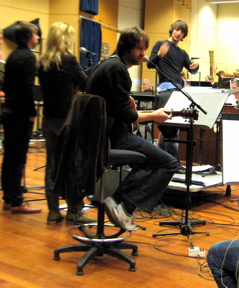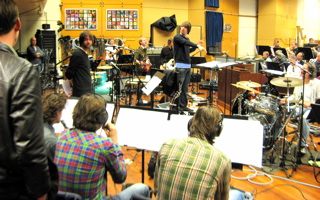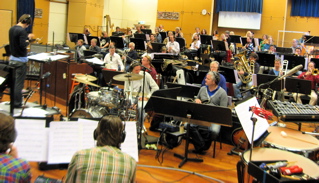Homepage > Documents > Musician Interview
Metropole Orkest musician interview with chief conductor, composer and arranger Jules Buckley
"The New Guy in Metropolis"
An interview with composer/arranger Jules Buckley
This interview was done on Friday 6 February 2009 at the Hilversum Studio 47, where Jules Buckley is conducting the orchestra for the television production "Het Metropole Orkest ontmoet ...", with singers Willeke Alberti, Angela Groothuizen and Cystine Carreon.
Biography and background
Asked about the Heritage Orchestra, Jules elucidates: "It is mainly a two-man initiative, calling a group of musician friends to do a club project. For some later productions we were writing the music real-time and via the LCD screens the musicians had to respond to that. My role sometimes was that of a mixer and a producer, indicating which lines the musicians should choose and the tempo. I would want to bring that innovative project to the Metropole, but upgrading that idea from the original 16 players to roughly 50 musicians will require some experimentation."
About his UK loop-based experience with Plaid, Amon Tobin, Unkle: "There's two ways of doing it. Artists like Nitin Sawhney come to the orchestra with pre-written stuff. The other option is more creative, and more unique: you bring the artists to the orchestra and you set them up with an orchestrator from their own choice. The nature of that approach I know more about than most orchestrators and composers. You would be brainstroming with the artist to determine their role." Asked about whether that will influence the orchestration, he responds: "Yes it will, but you can affect the string balance. I've done that a lot. In June 2008 I did the Blade Runner project with Massive Attack in London. We took the Vangelis score, and spent a long time just talking what we wanted to do with it. Then we got a team of orchestrators together, decided what to do and then we put it into a very large string ensemble and a large percussion section, with soloists Paul Bunyon and Guy Garvey from Elbow. The emphasis was upon that we could not re-create the Vangelis sound track."
Orchestration aspects
Writing for a studio orchestra like the MO involves a multitude of considerations. Jules Buckley, about his characteristic style elements: "My main principle is that, when it is a standard singer/songwriter gig (not my own projects), I would obviously write as much as possible for the MO, so that it will sound as an acoustic ensemble. That would give the sound guy and everybody else an easy day. However, sometimes even that is tricky; there is the 4 trumpets and 4 trombones in the big band group, so one has to balance the forces. In general, I try to do it according to some 'old school' rules, such as instrumental weighting. And then there are times when you are going to rely on the amplification. For example, take a big fat chord with the brass; then the winds are going to be stacked above them and strings electronically balanced as an ensemble. Simply, if you did not have the plug, then you are not going to hear the voicing otherwise. Vince Mendoza would probably agree with that, as would most orchestrators."
As to string writing: "It is important in an ensemble like the Metropole to be able to write for all the instrumental groups; you need to know everything about all of the instruments. Perhaps, sometimes the strings are neglected. You know, they are then playing long pads with all these 'egg-shaped' notes all the time. I myself have an affinity for a 3-octave string unison line, but it has got to be moving. And then I also like to use counterpoint, when I can. For instance, independently moving lines within a harmonic progression, when it is song-based. Or, on the opposite, throwing ideas amongst different instruments in a free form, which I have also dealt with.
The BBC Concert Band has about 35 string players, and a somewhat smaller brass section. So with the MO it is probably safer to use the single voice per part approach; divisi playing will weaken the over-all sound. When I conduct somebody else's score and I see an octave unison in the 1st violins, I will try to remove that. It is the difference between either seven or three players to the part and that is essential for a strong sound. I learned quite a lot about string playing and bowing techniques from a friend violin player. However, bowing marks are a tricky thing; I put more accents in the score and for bowing indications I use regular English text such as 'on the string' instead of the Italian vocabulary."
In answer to the question about the single French horn and the single oboe chair in the MO he responds; "Well, as a solution for doubling the horn part I sometimes write a bucket mute trombone unisono part. On the other hand, they are such monster trombone players, and therefore, pretending to sound like a French horn is not the best use; you'd have to ask them friendly. Alternatively, one could create a small mixed group, more-or-less a wind quartet, combining a flute, oboe, clarinet and horn. That will create a chamber music flavour; people do that a lot and it sounds great. However, the lack of a bassoon cannot be compensated for by a bass clarinet."
Studying classical music scores is still part of his routine: "Yes, I frequently study the French school, with composers such as Debussy and Ravel, who are masters at creating individual timbres, and using exposed instruments. On the other hand, there is the German school, with Beethoven, Mahler and Strauss; they contain so many great examples with doublings and mixed instrumentation and scale-of-sound. I study Richard Strauss for his tutti chord voicing. Doubling low clarinets or trombones with the low strings obviously yields a warm sound. But maybe that is not as adventurous as the French with one or maybe two instruments to a line. And Shostakovich symphonic scores are an excellent demonstration of unisono writing for high woodwinds and strings. When I study classical music scores, I always try to figure out why they made those decisions. Why did the composer double this line or why did he divide the violas this way? At any point in a score you should be able to explain and justify why you have written that; it just got drilled into me by my teachers at the School of Music."
Working with the Metropole Orchestra
Jules Buckley is a conductor, who changes between left-handed baton technique and hand-conducting, depending on the style of a piece: "I took classical conducting lessons; the point of the baton is still an excellent beat indicator. However, I admire somebody like Gergiev who will get maximum expression from an orchestra using his hands, or a toothpick."
Jules has numerous plans with the MO. He intends to do lots of projects with contemporary elements such as mixing sample-loop-based techniques (e.g., Square Pusher, Aphex Twin) with the live orchestra, featuring artists and DJ's from the UK club scene such as Unkle, 07, or Johnny Greenwood. "Artists that have credibility; that's the important thing. An orchestra like the MO deserves to work with unique artists. Everbody here is so talented. So you want to bring projects to the orchestra, that they actually feel, they get something out of it. When they do the jazz projects with Vince, they really get to play as an orchestra. So it is important that, by bringing over artists from different angles, it is not just about the artist being backed by the orchestra. It has to be on a level playing field."
Conclusion
There are many more things to ask, but after a day's hard work in front of the orchestra and TV cameras Jules Buckley is exhausted. So we decide to stop the interview at this point, with a promise to continue the conversation at some later time. I'm definitely looking forward to that.




